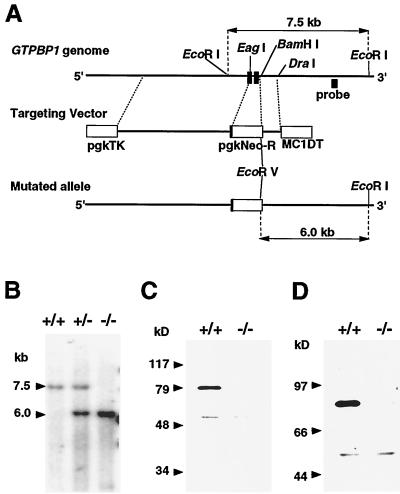FIG. 3.
Generation of GTPBP1-mutant mice. (A) Schematic depiction of a part of the mouse GTPBP1 gene, the targeting vector, and the mutant allele. Closed boxes indicate two exons coding for amino acids 17 to 77 and 78 to 193 (according to a previously published amino acid sequence [22]) of the GTPBP1 protein, respectively. The targeting vector contains a neomycin resistance gene (pgkNeo-R) for positive selection and the diphtheria toxin A gene (MC1DT) and herpesvirus thymidine kinase gene (pgkTK) for negative selection. (B) Southern blot analysis showing homologous recombination. Genomic DNA samples from a wild-type mouse, a hemizygous mutant mouse, and a homozygous mutant mouse were digested with EcoRI and EcoRV. The location of the probe, a 0.6-kb HindIII-HindIII genomic DNA fragment used for Southern blot analyses, is shown in panel A. The 7.5-kb band indicates the wild type, and the 6.0-kb band indicates the mutant allele shown in panel A. (C and D) Immunoblot analyses showing the absence of an intact GTPBP1 molecule in a homozygous mutant mouse. Lysates of brain were made from a wild type and a homozygous mutant mouse, electrophoresed in an SDS-polyacrylamide gel, transferred onto a nitrocellulose membrane, and probed with polyclonal antibodies GP1a (C) and GP1b (D), which recognize amino- and carboxyl-terminal portions of the GTPBP1 protein, respectively.

